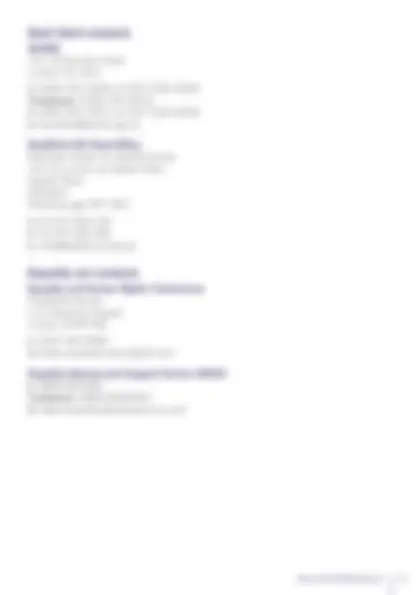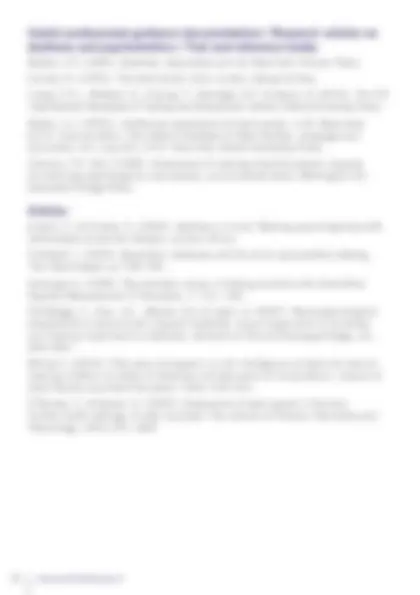


















Study with the several resources on Docsity

Earn points by helping other students or get them with a premium plan


Prepare for your exams
Study with the several resources on Docsity

Earn points to download
Earn points by helping other students or get them with a premium plan
Community
Ask the community for help and clear up your study doubts
Discover the best universities in your country according to Docsity users
Free resources
Download our free guides on studying techniques, anxiety management strategies, and thesis advice from Docsity tutors
Deafness and hearing loss and Adaptations during the assessment.
Typology: Lecture notes
1 / 24

This page cannot be seen from the preview
Don't miss anything!

















Practical advice for test users managing the testing
of people who are Deaf or have a hearing loss
The purpose of these guidelines
These guidelines are to help individuals holding BPS Qualifications in Test Use in occupational, educational or forensic contexts, who have a requirement to carry out psychometric testing with individuals who are deaf or who have a hearing loss. They may also be helpful to clinical, neuropsychologists and counselling psychologists who are required to assess such individuals..
Deafness and hearing loss definitions (in accordance with Action on Hearing Loss, formerly the Royal National Institute for Deaf People – RNID)
In a general sense, deafness refers to people with a range of hearing loss. In some cases, this is permanent and others may be more of a fluctuating nature, dependent upon the nature and reason for the deafness.
A hearing impairment is a hearing loss that prevents people from receiving sounds through the ear. Mild loss, means that the person will have difficulty hearing faint or distant speech. A person with such a degree of hearing loss may use a hearing aid to amplify sounds. Where a hearing loss is severe, the individual may not be able to hear or distinguish sound. There are different causes for such hearing loss / deafness:
■ ■ (^) Conductive hearing loss – this is usually in the outer or middle ear and can be caused by disease or obstruction. (This might for example be a wax build up for example, causing a more temporary period of deafness.) This kind of hearing loss can often be addressed by a hearing aid or sound amplification assistive technology, (for example inductive loop systems). Therefore, in terms of testing, use of a microphone and loop system might be effective for these individuals.
■ ■ (^) Sensorineural hearing loss – this is usually inner ear. This may affect certain frequencies. Sound might be distorted using a hearing aid. A loop system may not therefore be a possibility.
■ ■ (^) Central hearing loss – this is due to damage linked to the central nervous system.
■ ■ (^) Mixed hearing loss – this can be a mix of inner, central nervous system and outer / middle ear damage.
For the latter three causes, hearing aids and assistive technology may not be appropriate and the individual is likely to communicate using sign language.
The term ‘people with hearing loss’ is a generic term encompassing people who are deaf, deafened and hard of hearing.
People who are ‘hard of hearing’ usually refers to those individuals with a mild to severe hearing loss. This might also refer to people who have lost their hearing gradually, for example age related hearing loss.
Deafened people often refers to those people born hearing, but who have become severely or profoundly deaf having learnt to speak. Again, this may be gradual, for a variety of medical reasons or can also occur very suddenly, for example as a result of accident or trauma, (for example, stroke, brain injury etc.) or due to noise exposure. [There are a number of causes which are beyond the scope of this brief summary.]
impairment, some deafblind people may not be totally deaf and totally blind, there are differing degrees of both, dependent upon nature, extent and severity of visual and hearing loss. As with hearing loss, it can be congenital or acquired, (later in life), for example as a result of trauma or accident. It is also possible that other physical or learning disabilities may be involved. In cases of deafblindness specialised support and guidance is needed to ensure that needs are best met both in terms of communication and assessment. Such loss may be gradual / deteriorating over time, (as is the case with Usher’s Syndrome – a genetic deafness with progressive sight loss over time) or may be from birth, (congenital), for example due to maternal exposure to rubella. Specialised skills and knowledge are required to assess such individuals
Deaf/blind communication – Individuals who are deaf/blind require additional specialist assistance and will require some form of deaf/blind manual communication. This involves the interpreter using a ‘hands-on’ approach to allow the person to feel the signs by holding the interpreter’s wrists/hands or using tactile finger-spelling on the deaf/blind person’s hands. Individuals may for example use braille, so assessment may also require knowledge of working effectively with visual impairment as well as hearing loss. Such assessment is best conducted by individuals with specialist knowledge.
Deaf Community – The Deaf Community consists of deaf people who define themselves as a group, mostly those who use BSL. Deaf clubs and associations are where deaf people come together socially.
Finger spelling – Spelling-out words using the fingers – this tends to be used mainly for names, places and other proper nouns.
Hearing aid – An amplification device worn by a deaf or partially hearing person to assist hearing. Note that the wearing of a hearing aid does not mean that the person can hear perfectly or does not need an interpreter. There is considerable variability in the benefit gained by hearing-aid use; for some people, it assists merely with orientation to environmental noise while for others it is of great assistance in hearing speech.
Hearing loop – A sound system in which a loop of wire around an area in a building, such as a meeting room, produces an electromagnetic signal received directly by hearing aids. There are various types of loops:
■ ■ (^) Room loops – these can be used in larger rooms
■ ■ (^) Portable loops – similar in principle to the room loop, the microphone and amplification process are portable.
■ ■ (^) Counter loops – these are more permanent and enable dialogue at counters for example in banks to be directed via microphone.
■ ■ (^) Infrared systems – these are similar to other loops but use infrared.
More information about such systems can be obtained from Action on Hearing Loss.
Lip reading – Some deaf people do not sign and rely on lip reading. This group includes those who become deaf in older adulthood and those with mild hearing loss.
www.psychtesting.org.ukwww.psychtesting.org.uk 55
Others who are deaf from birth, by choice or chance, grow up without the opportunity to learn BSL, so they rely on lip-reading and speech may still be very difficult for them. It is important to note that lip-reading is very difficult and is further affected by unfamiliarity with the speaker, accents, or even beards. Even under optimum conditions (good light and being only 3–6 feet away from a questioner who is facing the deaf person and who does not look down while speaking), a skilled lip-reader who is not particularly anxious may still clearly understand only 25–40 per cent of what is said (www.hearinglink.org). This is because a high percentage of English words are not seen on the lips or look the same as other words. (Try looking in a mirror and mouthing the words ‘this’ and ‘these’, ‘walk’ and ‘wall’; ‘pale’, ‘male’ and ‘bail’).
In order to lip-read a word, you need to know that word already; hence for BSL users, whose first language is not English, many words are likely to be impossible to lip read. Remember that if a person has intelligible speech, this does not mean that they will necessarily be able to lip-read reliably.
Lip-speakers – are registered professionals who are trained to speak very clearly with lip patterns that are as easy to read for the deaf person as possible. Some may enhance this with finger-spelling and occasional signs.
Makaton – is a language programme using signs and symbols to help people to communicate and is usually association with people with a Learning Disability. It is designed to support spoken language and the signs and symbols are used with speech, in spoken word order. Makaton is a system of communication, borrowing individual signs from BSL, but is not a language per se.
Oral/aural – describes the process of relying on speech, lip-reading and technical aids to assist hearing.
Sign language interpreters / BSL interpreters – are qualified professionals who are skilled in the interpretation of English into BSL and vice versa and are accountable to their registration body, the NRCPD.
Sign Supported English (SSE) – refers to the use of BSL signs in English word order and implies that the individual’s first or internal language is English rather than BSL. In reality, many deaf people use a hybrid of BSL and SSE. In some instances, speech is used at the same time as SSE.
Total Communication (TC) – This is relevant when considering the deaf person’s background and education. TC is an acceptance and use of all means of communication, including sign language. This is in contrast to oralism, which promotes speech and lip-reading and discourages the use of sign language. Some deaf children will have been educated in a TC environment, others in oral schools.
Background / Equality Act 2010
Under the Equality Act 2010, disability is defined as, ‘physical or mental impairment which has a substantial and long term adverse or negative effect on the ability to carry out normal day to day activities’. For people with hearing loss or deafblind individuals, this could for example, include difficulty hearing or
www.psychtesting.org.ukwww.psychtesting.org.uk 77
validity of assessment and to avoid discrimination due to deafness. However, such changes to a test cannot be made without affecting its reliability and validity. Advice should therefore be sought from the test publisher or a Registered / Chartered psychologist with suitable exxpertise in assessing people with hearing loss before any changes are made. Publishers may be able to offer guidance and advice on appropriate adjustments to administration procedures and in addition, some Test Manuals will also offer advice. (A list of useful specialist contacts is attached.)
Discussing with the individual or others who know them about what works best for them, including how they best communicate and what adjustments they use in everyday situations will offer some guidance, for example, are they a lip reader; do they use sign language / require the services of an interpreter; can they hearing effectively with a hearing aid or an inductive loop etc. Finding out how the individual’s deafness affects them functionally, is always informative and may provide useful information in respect of reasonable adjustments in an interview or psychometric testing situation.
Practical advice in advance of the testing session
■ ■ (^) If you are considering test administration, you need to consider how you will communicate effectively with someone who is Deaf, with a hearing loss or who is deafblind. The first key question is whether the person’s first language is BSL or English. This has an impact on the types of tests which are reliable and valid and the extent to which adaptation is required.
■ ■ (^) This might require arrangements to test people individually or the setting up of specific arrangements, (for example use of a loop system), to communicate effectively. It is always useful to discuss with the individual how they best access communication and indeed potentially, access IT. Someone who is deaf blind for example, may be able to access IT but might require larger font size, different type faces or different colour combinations for example, dependent upon degree of sight loss.
■ ■ (^) When inviting people to a testing session, ask them to contact you in advance if they have a disability or any condition that might affect their performance on the tests. This allows the test user / administrator to seek advice and to prepare for any special needs in advance. You may for example want to invite an individual along prior to any testing session to discuss individual needs in more detail and, if required, to bring a support worker. (It should be noted that this applies to all test takers, no matter what their degree of hearing loss).
■ ■ (^) Providing any practice materials that are supplied with the tests in advance of the testing session, may enable test takers to check and consider if they would have difficulty with any of the tasks.
■ ■ (^) If a hearing loss is reported, ask, ‘how does it affect you?’. Enquire how the person prefers to access communication when interacting in an everyday
context, for example, what is helpful to them if they have a doctor’s appointment or a meeting at the bank etc. Individuals will be able to explain what works well for them, for example a loop system; the need for good lighting levels; good clear face to face dialogue etc. Individuals might also be able to let you know what support if any they have had previously in school exams for example, which might also provide useful pointers in terms of additional support, reasonable adjustment processes and communication needs in terms of assessment generally.
■ ■ (^) Think also about the room and location in which testing is being carried out. This is not only in terms of lighting levels in that room, but also wider issues such as does the room have an induction loop system or can you arrange to provide a portable loop system. Such devices allow people to hear sounds more effectively, by linking into the hearing aid and reducing any background sounds. When an individual’s hearing aid is switched to a T setting, (to the loop system), the focus is on the sound from the external (loop) microphone and not the internal microphone of the hearing aid, which picks up all sounds. In the latter case, all sounds are amplified making it difficult for the individual to differentiate. This system therefore focuses attention on the specific communication, enabling clearer, more focused communication.
■ ■ (^) It is important to note that letters sent in advance of the appointment may not be understood if English is not the person’s first language; avoid sending complex correspondence or questionnaires prior to the appointments.
■ ■ (^) A registered qualified BSL interpreter will be required and can be found at www.nrcpd.org.uk. When booking the interpreter, ask if they are familiar with working with a psychologist / working with psychometric assessments; if not you will need to arrange a half hour session prior to the appointment to brief them on the session.
■ ■ (^) In considering test materials, note that for first language BSL users, any questionnaire measure are likely to be unreliable and invalid, even if translated into BSL. This is because interpretation is in terms of meaning rather than exact words, rendering the measure no longer standardised.
■ ■ (^) Verbal measures, such as the verbal subtests of the WAIS-IV are not valid or reliable indicators of ability and should not be used. These tests are more a measure of the extent to which the individual has been able to access education via English, rather than revealing anything about their intellectual function. Verbal subtests should NEVER contribute to a Full-Scale IQ. The Perceptual Reasoning Index is a more useful estimate of ability / potential of a Deaf person. (It will indicate minimum level of (intellectual) ability for an individual.)
■ ■ (^) Non-verbal tests such as the performance subtests of the WAIS-IV are reliable and valid measures when used with deaf people (Braden 1994) although instructions in BSL do alter the nature of the test to some extent.
■ ■ (^) Do not shout or speak too loudly. This can seem aggressive and may be uncomfortable to the hearing aid wearer.
■ ■ (^) Whilst hearing aids make sounds louder, they do not clarify reception or understanding of the sound by the individual. Having a hearing aid does not mean that the individual can hear as normal.
■ ■ (^) Use written communication, a notepad and pen to write things down. Often this is a last resort, if other communication approaches have not worked. Even those with a mild hearing loss may have less well-developed reading and written literacy skills.
■ ■ (^) Group situations can be very difficult for a person with a hearing loss; consider avoiding this if possible. In any group situation, the individual with the hearing loss needs to be able to see others in the room and the chair must insist that people speak one at a time and indicate they wish to do so with a raised hand, so that the deaf person can orientate to the new speaker.
■ ■ (^) Ensure that visual aids are used where helpful; arrange a loop system. Lighting is crucial and good visibility of the speaker is key; do not stand in front of a window as you will appear as a silhouette. Ask the deaf person if the lighting level is ok.
■ ■ (^) Avoid background noise as this is distracting and makes use of residual hearing more difficulty.
■ ■ (^) Monitor reception of your communication, either by observing the individual’s expressions or body language, or by asking them to indicate if they have not understood everything. Repeat, explain further or use different words as needed.
■ ■ (^) Where difficult to receive communication as the listener, for example where an individual’s speech is not clear or is hard to understand, ask for repetition and clarity rather than making assumptions.
■ ■ (^) Simple, clear language without jargon or abbreviations is most helpful, as is checking out understanding on a regular basis.
There are a number of really useful Factsheets and guidance documentation on communicating with deaf people guidance, for example from Action on Hearing Loss, (formerly the Royal National Institute for Deaf People – RNID); SENSE provide useful information on communicating with deafblind individuals and there are a number of other support organisations signposted later in the document.
■ ■ (^) Use an appropriately qualified interpreter. If you have some BSL, it is appropriate to use this to ‘meet and greet’ the person. However, avoid using sign language for the formal part of the assessment if you not qualified, to avoid conveying incorrect information inadvertently.
■ ■ (^) The interpreter is a resource who can advise on communication, for example if the lighting and seating are appropriate.
■ ■ (^) The interpreter will tell you if s/he has the impression the Deaf person does not understand.
■ ■ (^) It is important that you talk directly to the individual who is deaf and not the interpreter.
■ ■ (^) Do not ask the interpreter about matters other than communication, as this is outside of their role.
The interpreter’s code of conduct requires that everything is interpreted; therefore, do not say anything you do not wish the deaf person to ‘hear’.
Making adjustments to tests
The standardised nature of psychometric tests is one of the main contributors to their effectiveness and objectivity, and any arbitrary modifications to the test or administration procedure are likely to invalidate the results and render standard norm groups and score interpretations meaningless. Changing the way, a test is administered can alter what is being measured. Professional advice will be needed to ensure that adaptations are appropriate and to offer guidance on how changes might affect interpretation of scores, as well as appropriateness of standard norm groups.
Therefore, where such modification is required, advice should be taken from a Chartered or Registered psychologists with expertise in this area or from the test author, distributor or publisher. They will have knowledge of the type and degree of modifications that might be needed. Equally, they will have knowledge of / expertise in terms of the impact of hearing loss and deafness, (the psychology of deafness). This knowledge will enable them to consider which tests may be appropriate and those which may disadvantage individuals, (create adverse impact), especially for those individuals with congenital deafness.
The way the person accesses any test will affect timings where tests have a fixed time limit. This is always something to consider.
The amount of extra time required will depend on the person’s disability, the tests being used, the way they are to be administered and their relationship to the characteristic being measured. Only a relevant professional can determine what is appropriate. An arbitrary decision should never be made.
Some test takers may want to bring along some special equipment (such as a portable loop system) or ask for specific lighting conditions or a room loop system. For other test takers, the best way to administer the test may be using interpreter support.
There is also a need to consider whether the individual can indicate responses in the standard manner. A modified answer sheet may be required by some deafblind individuals for example, or it may be more appropriate for the test administrator to note down the responses in certain cases, even when this is not the normal procedure. Where test takers are providing quite personal information, e.g. by answering a personality questionnaire, make sure that the administration method does not require greater disclosure than the standard procedure. For instance, responding to an interpreter will mean another individual is aware
Working effectively with prelingually profoundly Deaf people who are
sign language users
It is important to be prepared in order to work effectively with such individuals and to be aware that it is incorrect to assume that a hearing aid will resolve any communication difficulties. In reality this is unlikely to be the case and working with an Interpreter will usually be required for profoundly deaf individuals. There are useful guidelines on use of interpreters and being aware of such guidelines is important, as is working with an appropriately qualified Interpreter. (More information is provided later in this document.)
There are few psychometric materials available specifically for prelingually profoundly deaf people. Consideration of validity and reliability is important when using any test and equally so, with this client group, especially given any changes that are needed to the standardised approach when using an interpreter. Ensuring access to appropriate norm groups is also important.
Although there are some standards for psychological testing in terms of assessing people with disabilities, there is limited research to validate test accommodations, adjustments or modifications from the standard test administration process. Equally, there is a limited amount of guidance in terms of test interpretation for people with sensory disability generally. Where deviation from standard test administration is involved, for example introducing Sign Language, this can change the demand or nature of the task, (Braden 1994 and Maller, 2003). It can also affect functioning and performance on the test too, especially where people are deaf from birth. Equally, where people are lip readers, given that this is a complex skill, it lends itself to ‘guesses’ as many sounds look similar on the lips and are therefore difficult to differentiate. This changes the cognitive demand of the task and requires greater concentration levels. The need to repeat information and/or check out understanding is therefore crucially important. If a person is relying on lip reading, it is important to remember that a failure or erroneous response on a test item may simply reflect a difficulty in lip reading and therefore may not be reliable.
If working with an interpreter, there are also differences and BSL dialects around the country, so checking out a shared understanding of different signs may also be helpful. Some words may not have equivalent signs, so the signer may need to spell out words, which may bring into question whether this is fully understood by the receiver. Grammar and syntax of BSL is different to spoken language, (i.e. it is not a version of English, but an entirely differing language) and this too may impact on the communication process. A signed interpretation may need to offer or provide additional cues, may present more or less information than in a comparable spoken presentation due to the nature of signing and also, as a consequence of cultural differences in the deaf community. Asking a deaf person to point at their ear, for example, will require the interpreter to sign such instruction literally.
Being aware of the impact of prelingual deafness in particular is important, as this can impact on the development of English Language verbal skills, (reading, writing or understanding of words, grammar or syntax more generally) and the gaining of
incidentally acquired knowledge generally. Research has shown that verbal skills and reading fluency of this groups of individuals is different to hearing individuals, therefore use of tests that are heavily verbally loaded is highly questionable. Verbal items or tools are generally therefore considered inappropriate for this client group, with performance measures generally being better indicators of capacity. This has tended therefore to lead to performance scales of intellectual ability measures being used to provide an estimate of overall level of intellectual ability, rather than focusing on or including verbal scales (Braden 1994) BSL (British Sign Language) has a differing vocabulary and grammatical structure and in addition, research, (for example Conrad 1979; Kyle 1980, 2005) has shown reading age to be lower in deaf school-leavers than comparable aged hearing school leavers, (Conrad has estimated for example a 7-year-old level of reading capacity for deaf school leavers who are profoundly prelingually deaf.) Such differences relate to the psychology of deafness / hearing loss, so being aware of research and literature is important, hence why speaking with relevant professionals and subject matter experts can be helpful. Likewise, exploring if / where there are norm groups for hearing impaired individuals is helpful. [Raven’s Standard Progressive Matrices for example has been normed on hearing impaired individuals. The Leiter 3 International Performance Scale is another tool sometimes used with this client group and again has some normative data.] Seeking advice from Registered / Chartered psychologists with knowledge of the psychology of deafness is therefore helpful to ensure that you are not inadvertently disadvantaging or discriminating a deaf individual or misinterpreting outcomes of measures.
Even with performance tasks there will be verbal instruction, so again potential for discrimination to be introduced and even working with an interpreter, will of necessity mean that administration deviates from standard. Even where there are attempts to address cultural differences, for example referring to texting rather than using a phone, there will be difference in terms of experiences. Using a normative group which includes deaf individuals where possible therefore is important. Norms for deaf people are not common and there may be value in comparison of the individual with both hearing and deaf individuals when trying to draw any conclusions from psychometrics.
Even where communication and interpretation is effectively in place, it is important that items in a test are discussed with interpreters in advance where possible. It is helpful for you as the Test User to be aware of the nature and implications of the signed administration so that the psychometric equivalence of the standardised version, versus the signed administration of that item can be considered. There may be an assumption that verbal information can easily be translated into BSL and be understood by Deaf individuals in exactly the same manner, but this is not always the case. Therefore, using verbal measures can be misleading and may not be valid. Also, some signs are visually similar in terms of hand shape and also, signed in similar positions, which in themselves might offer cues not be available to hearing individuals or alternatively, might be misleading and lead to confusion between different signs, lending themselves towards
language used is often quite complex and sophisticated in nature, requiring understanding of concepts and opportunity for certain experiences. For these reasons and in addition to the fact that the experiences and the culture of deaf individuals is different, the recommendation is not to consider using personality tools with Deaf people. Conclusions reached can be erroneous and highly questionable (O’Rourke, S. & Grewer, G., 2005).
In non-verbal tasks, items can also be complicated, difficult to interpret exactly and may also need English grammar understanding to fully appreciate requirements. The way in which instructions are given is also potentially different, for example, where visual information is laid out to observe, the deaf individual is watching the signed communication, not looking at the cards at the same point as a hearing person, who would therefore be afforded additional exposure time. The deaf person starts the task therefore at a different point in time.
The point at which a person loses hearing is relevant, with those people who lose hearing prior to acquisition of spoken language being qualitatively different to those who lose hearing later. The exposure to spoken language and corresponding development is different at different developmental stages so this plays a part in understanding of test information. There is also known to be differences where a deaf child has hearing or deaf parents; the latter being more likely to be accomplished BSL users. Deaf children or hearing parents may not have been exposed to BSL until quite late, depending on their educational experiences and therefore have had no effective language until this age. This is of obvious significance in terms of learning and development. Being aware of such background information may be helpful when interpreting test outcomes and such issues should be explored when using tests, to aid interpretation.
Such factors indicate that choice of test, how information is interpreted and the process of administration itself are far from straightforward, and may suggest a referral to a specialist is appropriate. Outcomes offer an indication of functioning for deaf individuals, but communication about the potential and nature of possible error sources is important when using psychometrics with this population in particular.
Useful contacts
Action on Hearing Loss (formerly RNID – Royal National Institute for Deaf People) 19–23 Featherstone Street London EC1Y 8SL
Information line: 0808 808 0123 Textphone: 0808 808 9000 SMS: 0808 808 9000 e: informationline@hearingloss.org.uk w: www.actiononhearingloss.org.uk
Tinnitus information line: 0808 808 6666 Textphone: 0808 808 9000 SMS: 0808 808 9000 e: tinnitushelpline@hearingloss.org.uk
Action on Hearing Loss Shop: 03330 144525 Textphone: 03330 144530 e: solutions@hearingloss.org.uk
For information about making services fully accessible for people who are deaf or hard of hearing, the Louder than Words team are useful to be aware of: t: 0333 240 5658 Textphone: 0161 276 2316 e: access.solutions@hearingloss.org.uk
SIGNATURE (formerly Council for Advancement of Communication for Deaf People) Mersey House Mandale Business Park Belmont Durham DH1 1TH
t: 0191 383 1155 Text: 07974 121594 f: 0191 383 7914
NRCPD c/o Mersey House Mandale Business Park Belmont Durham DH1 1TH
t: 0191 383 1155 Text: 07974 121594 f: 0191 383 7914 e: enquiries@nrcpd.org.uk w: www.nrcpd.org.uk
National Deaf CAMHS (Central England) Canalside House Abbotts Street Walsall West Midlands WS3 3AZ
t: 01922 608822 f: 01922 607825 e: deafcamhs@dwmh.nhs.uk
Forensic Mental Health and Deafness
Rampton Hospital (High Secure) Woodbeck Retford Nottingham DN22 0PD
t: 01777 248321
Cygnet Hospital (Medium and Low Secure) Buller Street Bury Lancashire BL8 2BS
t: 0161 762 7200
All Saints Hospital (Medium and Low Secure) Grange Avenue Oldham Greater Manchester OL8 4EF
t: 0161 622 4220
St Andrews Hospital (Medium secure) Cliftonville Rd Northampton NN1 5DG
t: 01604 616000
Independent psychologists working with deaf people can be found at: w: www.deafexpert.co.uk
Other associations
British Deaf Association Head Office 3rd Floor 356 Holloway Road London N7 6PA
t: 020 7697 4140 SMS/FaceTime: 07795 410 724 ooVoo/Skype: bda.britdeafassoc e: bda@bda.org.uk
Action for Deafness 22 Sussex Road Haywards Heath West Sussex RH16 4EA
t: 01444 415582 e: info@actionfordeafness.org.uk
ActionDeafness 1st Floor Peepul Centre Orchardson Avenue Leicester LE4 6DP
t: 0844 593 8440 f: 0844 5958441 Minicom: 0844 5958445 e: enquiries@actiondeafness.org.uk w: www.actiondeafness.org.uk
Royal Association for Deaf People Offer Interpretation Services t: 0845 688 2525 e: info@royaldeaf.org.uk